What’s Best For You: the Tension Board 2, the 2024 MoonBoard, or the Woods Board?
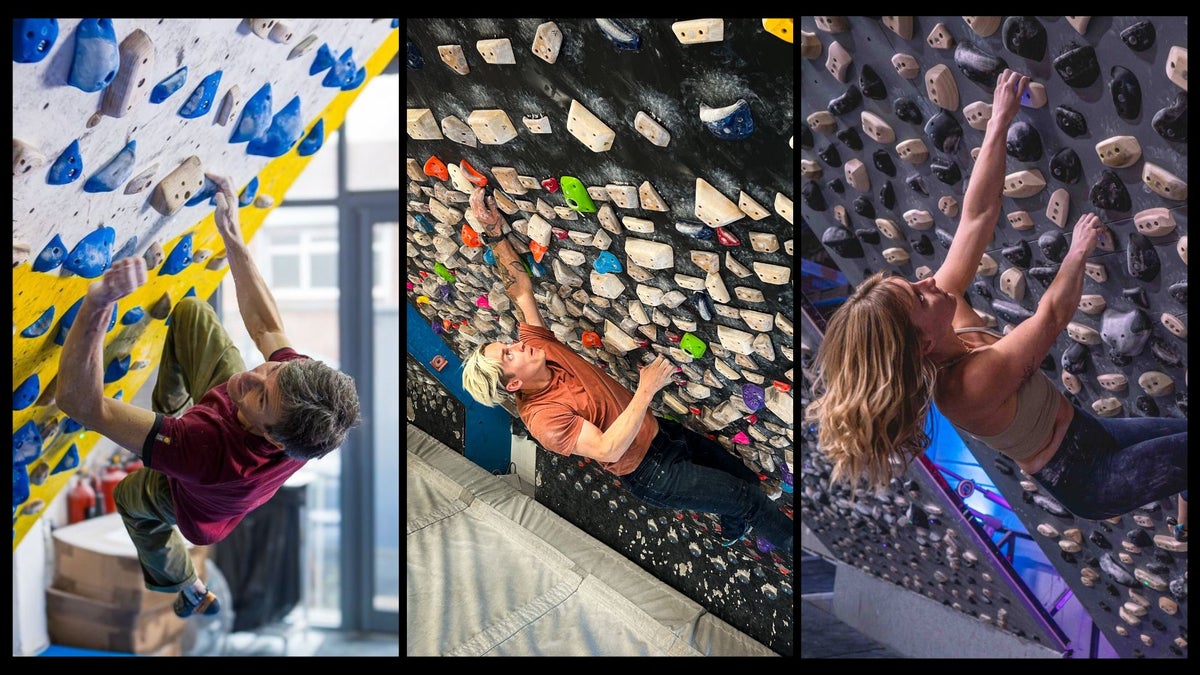
It’s an exciting time in app-driven LED board-land. Two venerable board makers, Moon Climbing and Tension Climbing, recently released new hold sets, while a relative newcomer to the board market, Menagerie Climbing, is getting their hyper-dense Woods Board out there—and Kilter and Grasshopper seem to be going stronger than ever, with their popular walls showing up in gyms and garages all over the world.
This is all great news for, well, pretty much everyone, from neophyte boulderers looking to condition their fingers, core, and “snap” as they advance through the grades, to sport climbers like me who cross-train on boards for route cruxes and strength-endurance, to double-digit beasts who need that next level of crimpy, powerful challenge often missing from present-day, macro-focused commercial setting.
Boards have been a time-proven way to get diesel for the stone since their inception in Sheffield, England, in the late 1980s. There, with famously wet, gloomy weather, climbers are inside a good chunk of the year but need to stay strong; homes in the climber hub of Sheffield are constructed with cellars (low-ceilinged basements), providing a convenient venue to throw up a steeply angled plywood wall and screw on little bits of wood. It was training on these first simple home “woodies” that let climbers like Ben Moon, Jerry Moffatt, and Malcolm Smith send some of the world’s first 5.14+ sport routes and V13 boulders. The technology has since come a long way, and a climber of that era would surely be blown away by the modern light-up boards that let them not only set their own problems, but also choose from tens of thousands of blocs set by climbers all over the world.
I’m something of a board fiend myself—I’ve had a Grasshopper frame at home since 2019, always with a MoonBoard going back to the 2017 set—so I was excited to check out the newest offerings to hit the market and see how they stack up against older boards and each other. I pitched one to three sessions on each before writing this review; as I tested, I considered (and solicited feedback from other climbers on) hold texture, shape, comfort, layout, and variety; wall angle (adjustable or not); the movement the board most typically produced; the app’s user interface and database of problems; and who the wall might be best suited for.
Tension Board 2

The original Tension Board (TB1) occupied a unique niche in the board market, presenting an all-wooden, mirrored board that was skin-friendly but austere. It felt hard to make progress on the TB1: For mere mortals, the board offered big, friendly incuts and large moves on juggy pinches and symmetrical balls, but everything else felt either ferociously small or way too slopey, at least on a steep (30-plus°), fixed-angle wall. And many of the micro-crimps were uncomfortably angled and textureless, which just made my fingers ache.
The new iteration, the TB2, fixes pretty much all these issues, with larger, much comfier wooden holds (33 new shapes), no more weird wooden bowling balls, and the addition of dual-texture polyurethane plastic holds (112 new shapes). All the various wall-size iterations offer two different layout options: “spray” (a somewhat random dispersion of holds) or “mirrored” (as with TB1), so you can pick your poison. The new plastic grips range from oblong slopers and meaty pinches to classic Tension micro-crimps, with a handful of concave jugs thrown in.
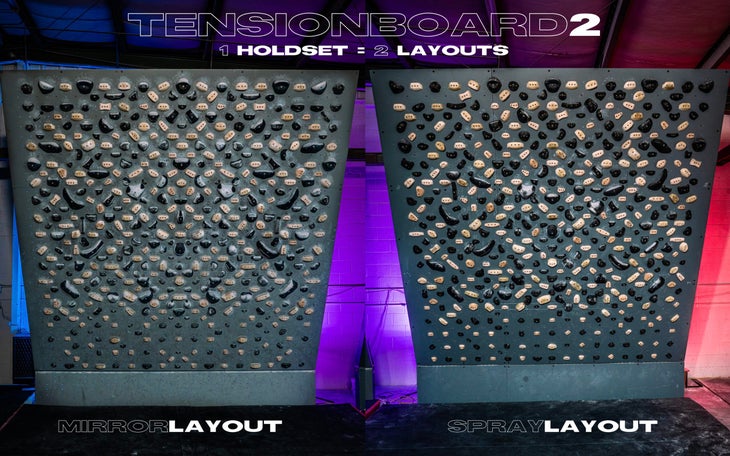
I tested the 12’ x 8’ TB2 on a fixed-angle wall at 40° at Whetstone Climbing in Fort Collins, Colorado, and on an adjustable frame at Movement Boulder. I noticed a few things right away: 1) I was having way more fun than on TB1, because the movement is springier and more varied, and my fingers hurt less. 2) Given how small the footholds are on the lower quarter of the wall, I was forced to use precise footwork at all the grades, which rewarded strategy, attentiveness, and tension—just like rock. And 3) The grippy feel on the new plastic holds—other than the slopers, which tend to get slick with use—let me dig deep and fight for moves with minimal dry-firing. I sampled pretty much just the “Classics”—i.e., benchmarks, marked with a “C”—and found consistent, kinesthetically pleasing movement, with some memorable big huck-type problems thrown in. The TB2 truly is a fun and varied board, with many holds incut enough that they’ll be useful even at 50-plus°.
Meanwhile, the decision not to put holds on the kicker panel does seem to foster more egalitarian setting for climbers of various heights, but the one drawback is that problems can feel “short,” especially if they don’t go to the top row. That said, if you want to work two- to four-move raw-power blocs on a mixture of plastic and wood, TB2 may be the best board on the market. I didn’t get to test the larger version, but it looks sick and will of course allow for longer problems, and the one I saw at Ascent Studio in Fort Collins was in constant use.

Pros:
- The skin-friendly wooden incuts are a pleasure to grab, with a great, ergonomic feel.
- The mixture of wood and polyurethane provides more varied setting than TB1, as does the option for “spray” or “mirror” hold sets.
- The adjustable angle expands the grade range, and you can actually warm up at lower angles.
- The tiny footholds in the lower quarter favor precision and body tension, simulating rock climbing.
Cons:
- With no footholds on the bottom kicker panel, the problems can feel “short” (at least on the 12’ x 8’ wall), especially if they don’t finish in the top row.
- The plastic slopers and small feet on the bottom third can grease out on a high-traffic board.
- Some holds slightly block other holds.
Hold Comfort: 4/5
Texture: 4/5
App quality: 4/5 (easy enough to use once you poke around a bit—same UI as Kilter, so if you’re familiar with one, you’re familiar with both)
Unique Features
- Adjustable-angle wall with no footholds on the kicker panel but very small, body-tension dependent footholds in the first four rows.
- Problems can finish on any row, not just the top.
- All layouts can be installed as either “spray” or “mirror.”
- Problem database has “Classics” (marked with a “C”).
Who is the Tension Board 2 best for?
With the ability to adjust the problem angle in the database and a wide variety of incut crimps, finger buckets, and whole-hand slopers, the Tension Board 2 will appeal to boulderers of all abilities, from V1/2 up to double digits. You can also set circuits using the app, if training resistance. Though it’s barely a year old, the TB2 is already one of the more beloved boards on the market.
Price
$8,363.19 for the 12’ x 8’ wall, all hold sets + LED kit
$12,204.12 for the 12’ x 12’ wall, all hold sets + LED kit
2024 MoonBoard
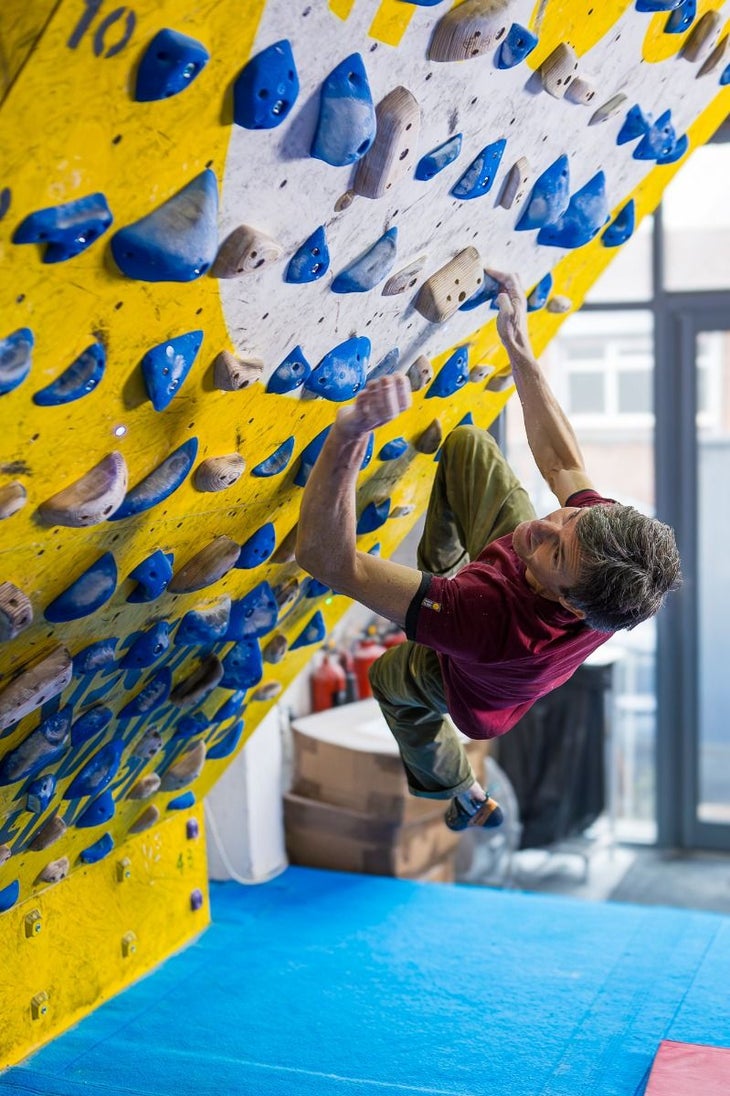
The MoonBoard is the original standardized-wall company, going back to around 2004 (yes, you read that correctly), when the UK legend Ben Moon started selling hold sets based on the wooden crimps on the School Room wall. The problems on these Original Holds started at V6, and readers could submit them via the Moon Climbing website, then download PDFs to try others’ creations. In 2016, Moon Climbing released the first-ever app-driven, light-up wall, sparking today’s board revolution. The 2016 set had a very specific crimpy, jumpy feel, and it still has its diehard adherents, to whom it’s sacrilege to suggest that any other set could ever be better.
Well, I’ll be the heretic who suggests that 2024 is Moon Climbing’s best set yet, namely because it addresses the board’s traditional shortcomings: slippery texture; sharp, 90-degree lips on the holds that could be hostile to the skin and made for a certain homogeneity of movement (toe in, crimp down, rock over, jump!); and tweaky holds like monodoigts (2016 set) and the two- and three-finger yellow microcrimps (2016, 2017, and 2019) that truly imperiled finger tendons.

First and foremost, the texture: I have horribly dry skin that gets glassy in winter, so I’m particularly attuned to hold material. I have a Grasshopper frame in my garage that I’ve been running MoonBoard sets on for five years, and in the colder months—primetime for training—I found myself dry-firing off the MoonBoard plastic more often than not, losing skin, getting angry, and limiting progress. By moving from polyurethane to polyester, Moon finally solved the problem: I’ve only dry-fired once off the new holds during my first two sessions; the holds feel like tight-grained sandstone, grippy like a good day at Font, and have brushed clean of chalk and boot rubber much better than the old plastic grips, which, because of their abrupt angles, also collected gunk like a rain gutter does leaves.
Second, the shapes have evolved to masterpiece level, taking the best aspects of the previous sets to create Moon Climbing’s friendliest and most varied board yet. No crimps are less than four fingers, all the amazing wood holds from the killer 2019 set are still on there (minus two grips) but have been oriented in new, more interesting ways. (One result: the MoonBoard finally has proper underclings instead of funky hamhocks.) Meanwhile, the new, blue hold sets—D, E, and F—are über-ergonomic. They feature rounded lips and broader radii; sculpted wrinkles and thumb-catch options that make for more complex movement; finger buckets and deep, fun-to-grab pockets that encourage creative, big-span and Rose moves that feel almost Kilter Board-ian; and sloping pinches you can actually stick to—unlike the notorious “cherry bomb” red holds on the 2017 set. And, in many cases, the new MoonBoard holds have downsloping upper aspects that force a slower, more tensiony, core-intensive style instead of the classic MoonBoard “jump-and-catch” encouraged by the older sets’ more positive feet.
I’ve pitched two big sessions on the 2024 MoonBoard so far, and I honestly can’t see going back to the old setups—and this isn’t just the novelty speaking. The 2024 is just a way better MoonBoard, and it may very well be the best 12’ x 8’ board on the market. If I had a ding, it would be the finishing row: three of the four wood holds are far from incut, and the E18 pocket remains as shallow and tweaky as ever. With the board rules requiring a two-second match on a single finishing hold to show control (holding and then bringing your other hand to touch), any problems that finish by matching on one of these grips only will surely require double-digit strength, which excludes many users and limits setting options.
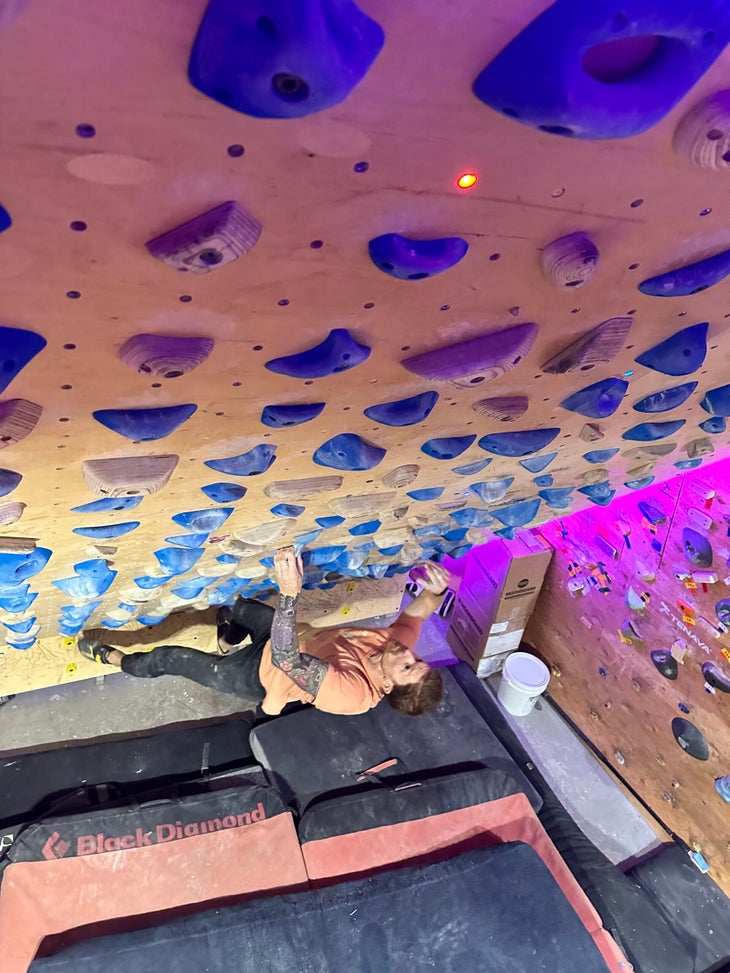
Pros:
- The sticky, tight-grained texture on the polyester holds is a huge step up vs. old polyurethane hold sets, which got slippery fast (the black holds especially).
- No more tweakage-inducing micros! The holds are ergonomic and comfy, with proper pinches, underclings, and four-finger crimps.
- The holds are also larger, with occasional backing plates, and often sloping on top, making for more varied footwork.
Cons:
- The fixed-angle wall reduces the possible grade range and makes it harder to safely warm up on the wall.
- The fixed kicker panel still tends to favor taller climbers, who can stretch long off the starting holds and jump to the middle of the wall.
- The finishing row still has a few holds (the smaller wood ones) that only feel usable for double-digit climbers if you’re forced to match.
- MoonBoard sandbagging remains alive and well—prepare to see your dreams crushed.
Hold Comfort: 5/5
Texture: 5/5
App quality: 3/5 (works well enough and is more intuitive than previous iterations; however, I couldn’t get the updated app to work on my older iPhone 8, though Moon Climbing did try to help and the app seems to work fine on newer phones)
Unique Features
- As with all MoonBoard sets, 2024 uses a vertical kicker panel with 10 fixed-location footholds.
- The board itself can be tilted at 25° or 40°, though 40° is far and away the more popular option (I have yet to see a 25° MoonBoard in the wild—does anyone actually have one?).
- As previously, all problems start in the bottom six rows and finish on the top row.
- Curated list of benchmarks gives users progress targets.
- LED System 3 lets you run multiple MoonBoards side-by-side, as well as light up holds from either above or below.
Who is the 2024 MoonBoard best for?
The 2024 set begins at 6B/V4—unlike 2017 and 2019, both of which start at 6A+/V3—and has very few jugs, but it does have a fair bit of medium-sized incut and pinch holds that lend themselves well to the V4-V6 range. It’s thus for intermediate/advanced boulderers and sport climbers, on up to elite. You cannot set circuits with the MoonBoard app (and IMO the wall is too hard for this at 40°), but you can certainly train resistance by doing 4x4s.
Price
£3,800 for all six hold sets—three plastic + three wood (198 holds total + 10 footholds)—for the standard 12’ x 8’ wall
Additional £500 for the LED System 1 or £700 for the LED System 3
More info on Moon Climbing’s website.
The Daniel Woods Light up Training Board—a.k.a. the Woods Board
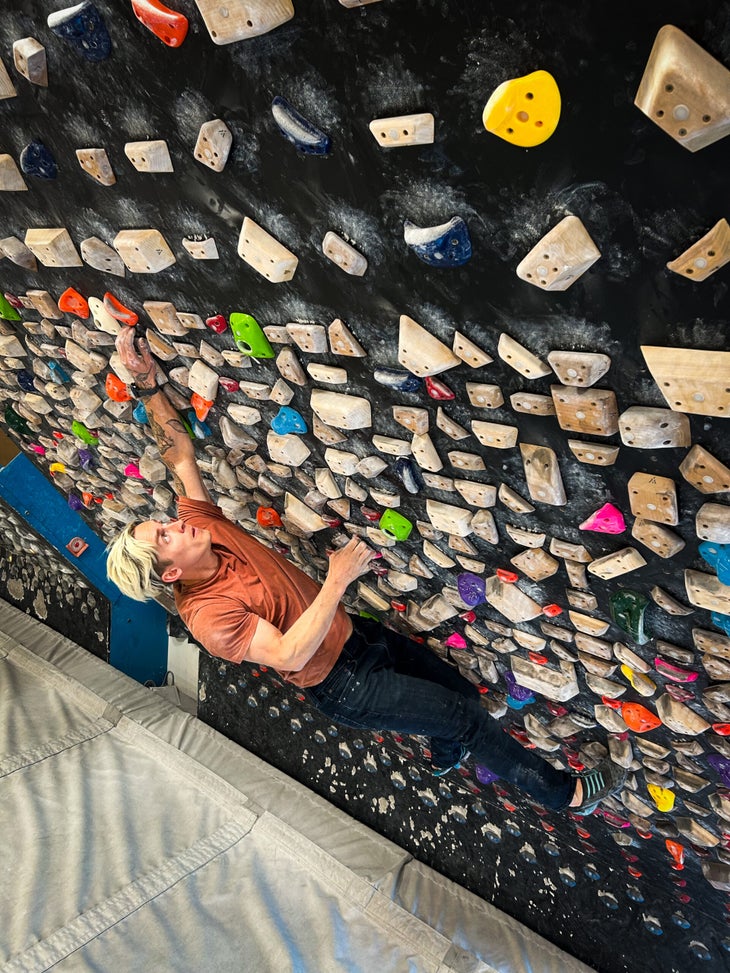
As a new adjustable wall was going up last month at The Spot Boulder, I remarked to my friend Derek, “That’s going to be a huge-ass board.” I had no idea which hold set was going on it, just that it had a tall kicker panel (3 feet) and some serious vertical height (another 12 feet) when fully tilted up. Any problem at a lesser angle was going to be a highball, even with good padding.
It turns out that The Spot was installing the Menagerie Climbing Woods Board, designed by company owner Andy Raether with input from Daniel Woods. The Woods Board features a hold set that works from 20–70° overhanging, and, with its staggering 726 grips, it must have the highest hold count and density of any light-up wall on the market, with the holds mostly spaced 10 cm apart instead of 20 cm. The idea, as Woods posted on Instagram, was to have a wall that had so many grips—most of them tiny wooden crimps and pinches, with some plastic footholds, finger jugs, underclings, and micro-crimps thrown in—that he (and other top mutants) wouldn’t quickly run out of challenging options. If that was the goal, I’d say they nailed it—the Woods Board is a mirrored system wall that nicely re-creates the feel of the Colorado Athletic Training School (CATS), the uber-high-density spray wall on which Woods has trained for years and established problems up to V15.
View this post on Instagram
I climbed on the Woods Board at 20°, 30°, and 40°, joined by a few other curious boulderers at The Spot. We quickly reached a consensus that we loved the board most for its incut wooden crimps and pinches, all of which had a smooth, skin-friendly texture and cool, engaging, ergonomic, geometric shapes. Most of the plastic holds are fun to grab too, but there are none of the true hand-swallowing buckets you can find on Kilter, Tension, and, to a degree, Moon; even the “jugs” are fairly aggressive, with cuplike depressions and dual-tex that forces precision feet on the tops, corners, and edges as you move past—cool for advanced climbers but punishing for newbies. Speaking of which, the board’s holds are so close together that you very rarely get to cheese the beta with a heel or toe-hook, and in spots you must floss your toes or fingers into “pockets” between the holds. This forces precise, controlled, powerful movements reminiscent, fittingly, of Daniel Woods’s style. This board is all about pure pulling, and it will make you strong.
It will be interesting to see how the database of problems evolves as more of the Woods Boards get out there. Right now, the “Standards” (benchmarks) as a rule seem strenuously undergraded and are often low on foot options—favoring raw lockoff power. In fact, I found them to be so sandbagged that it was hard to calibrate my session or see much progress, which may frustrate some users—not just for grade-chasing reasons, but because it’s just so damned hard to get up the board. On the flip side, we did find a handful of problems that felt graded fairly and that were awesome to climb on, with pleasing, powerful, jumpy movement, showcasing just what can be done with this monster, pinch-and-crimp-ninja board.
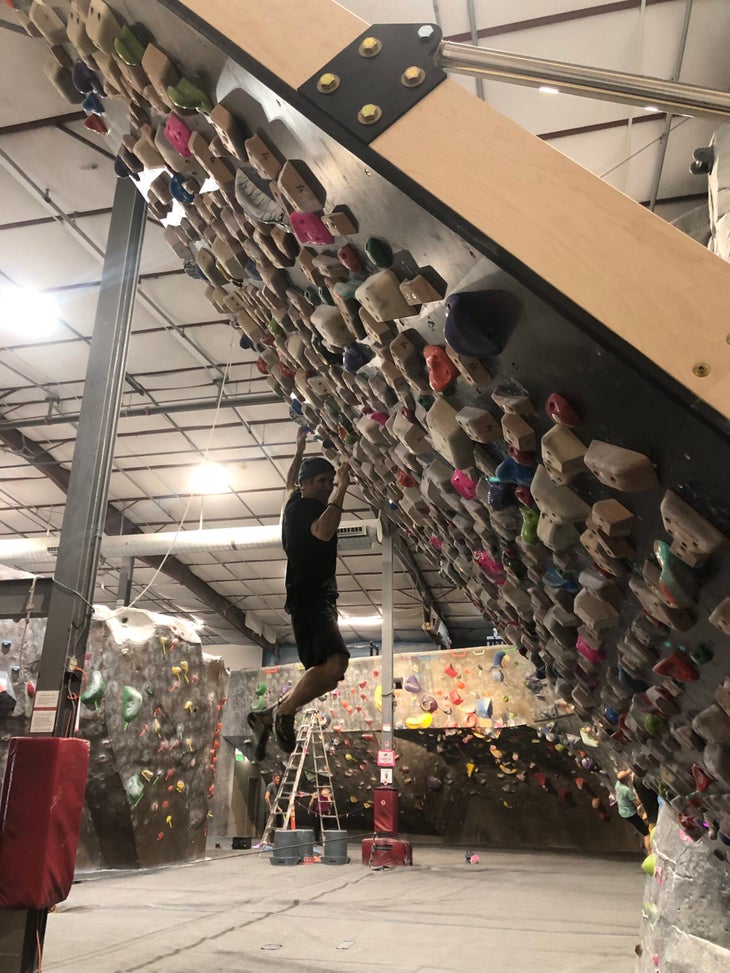
Pros:
- A mind-blowing number of holds (726) and huge board size (12’ x 12’) make for limitless setting potential.
- Dedicated footholds on the kicker panel and lower three rows, as well as scattered throughout the board, are the perfect size and angles for precise, kinesthetically pleasing footwork.
- The incut and sloping wooden crimps are skin-friendly and come in varied, geometrical shapes.
- The pinches are sloping near the back to form a “ramp,” making for technical yet ergonomic pinch problems.
- The lights in the middle of the holds are highly visible on the go.
Cons:
- The plastic finger-buckets (especially the green ones) can be painful on the lower fingerpads when going to them dynamically.
- Right now, the “Standards” (benchmarks) are incredibly sandbagged, like V2s at 20° that pull on two-finger micros and V5s at 40° that use the same holds…even by board-sandbagging standards, the Woods Board grading scale is punishing.
Hold Comfort: 4/5
Texture: 4/5 (wood holds are smooth and cool on the skin; dual-texture plastic holds are grippy on the grabbing spots but force precise footwork on the tops, corners, and sides once you climb past)
App: 3/5 (the current app is bare bones but user-friendly; Menagerie Climbing’s owner, Andy Raether, says that they’ll soon be adding “significant logbook/account features, playlists/circuits, leaderboards based on the yellow Standards problems, search by hold, total filtering, and search upgrade and overhaul”)
Unique Features
- Adjustable angle from 20-70°, with giant (two-row) vertical kicker panel, plus the lower three rows dedicated to feet only, and the upper three rows dedicated to spread-out finishing holds.
- Insane hold density in the middle of the board, with holds 10 cm apart—not the usual 20 cm spacing; has “Standards” (i.e., benchmarks) at all the grades.
- Problems can be flipped (mirrored), as it’s a symmetrical system wall.
Who is the Woods Board best for?
It’s for diehard boulderers, mostly advanced to elite. With its mammoth size, panoply of tiny wooden crimps, and ability to go to 70° overhanging, this board could probably host 9A/V17 boulder problems.
Price
$13,400 for the 12’ x 12’ wall, which comes with a whopping 726 holds, 70 percent which are wood, 30 percent plastic (with customizable colors).
A 12’ x 8’ wall is coming soon—likely late 2024
More information available one Menagerie Climbing’s Website
So how do they stack up against each other?
It was a joy, albeit of the ass-kicking kind, to test all three new boards, and it will be interesting to see how the community around each evolves as the database of problems expands and the grades and styles solidify. For the home user, the MoonBoard 2024 set and the 12’ x 8’ TB2 are the most affordable options for now, but stay tuned to Menagerie to see what their smaller Woods Board will be all about. My guess is that for “board casuals,” the adjustable TB2 will be the most popular, as it has grades down to V0; next best will be the finger- and skin-friendly 2024 MoonBoard. (Though I should note that, at gyms, the big Kilter Board, with its adjustable angle, welcoming holds, and fun dynos will probably remain a perennial favorite for the board-casual crowd as well as for diehards training dynamic motion.) For the double-digit hardcores, the Woods Board is the thing: one-stop shopping for the toughest light-up crimping and pinching on the market. But let’s be honest: all three of these boards are pretty dang sweet.
Related:
Matt Samet is a freelance writer and editor based in Boulder, Colorado. He is the author of the Climbing Dictionary and the memoir Death Grip.
The post What’s Best For You: the Tension Board 2, the 2024 MoonBoard, or the Woods Board? appeared first on Climbing.

